#common garden snail
Explore tagged Tumblr posts
Text
watching danny gonzales with ringo :)

#snails#snail#snailblr#my snail#pet snail#pet snails#cornu aspersum#garden snails#garden snail#common garden snail#ringo the snail#ringo snail#my post#snail posting#danny gonzalez
27 notes
·
View notes
Text
one of my favorite things about using inaturalist is how it’s gotten me familiar with even the common, less “impressive” species. especially since spring is rolling around and I’m spending more time outside.
Like, before where I’d just say, “oh look, a butterfly!” now I can say “oh look, a mourning cloak!”
Instead of “a squirrel” it’s “a fox squirrel.” Instead of “a snail” it’s a “garden snail.” Instead of “a rabbit” it’s “a desert cottontail.” Instead of “a ladybug” it’s “an asian lady beetle, which is invasive.” Instead of “a lizard” it’s “a bluebelly, but they’re really called western fence lizards.”
It’s harder to take the little guys for granted when you know their names, y’know?
5K notes
·
View notes
Text
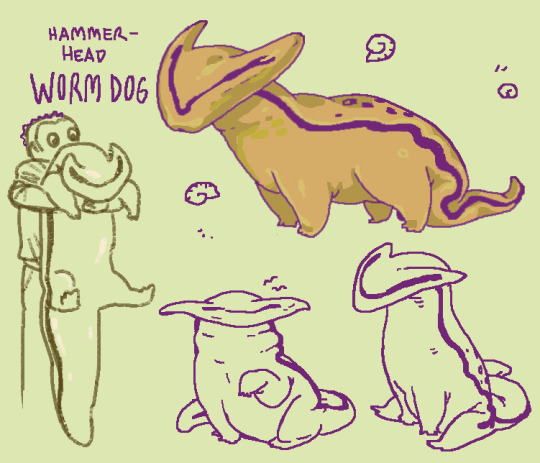
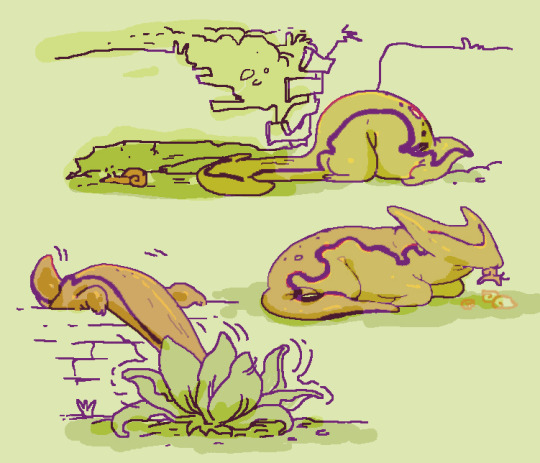
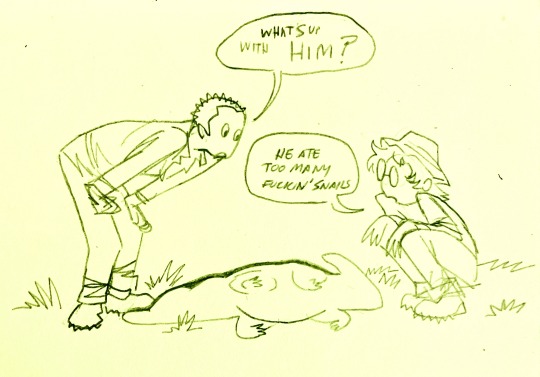
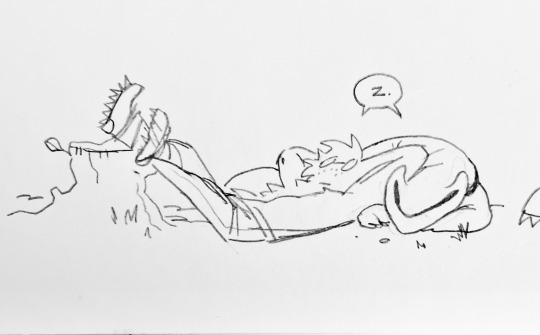
the garden i tend at work is getting overrun with snails so i thought about a world where we acquired a domesticated a "working dog" breed of hammerhead worm (they eat snails and slugs and worms) that is also. a puppy. Bred to clear vegetation of common slimy garden pests. click under readmore if u wanna see the worm theyre based off of i think theyre really cute
Itch.io / Redbubble / INPRNT / Twitter / Patreon


#in this world hammerhead worms are not a noxious invasive species im just having fun#art#my art#hammerhead worm#wormdog#vyscera#his ass is NOT allowed near the worm compost bin#worm
12K notes
·
View notes
Text
Common Garden Snails can have around 14,000 teeth in their radula. However, some species can have up to 20,000 and some, like the limpet sea snail (Patella vulgata) have teeth that are five times stronger than spider silk making it the strongest natural material on Earth!
26 notes
·
View notes
Text
SeaWing guide
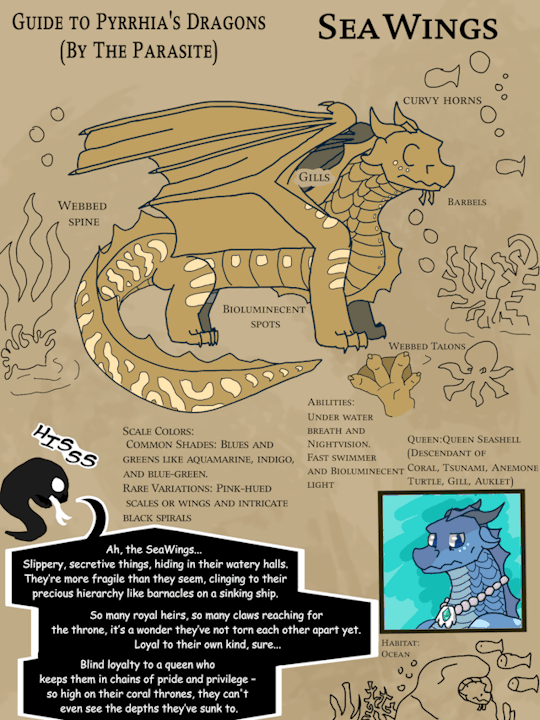
HELP ITS IN MY SPINAL CHORD
ITS SLITHERING CLOSER TO MY BRAIN (From the wikifandom) SeaWing Overview
Alternate Names: Often called sea dragons or ocean dragons by humans.
Primary Habitat: Kingdom of the Sea, an expansive underwater realm in Pyrrhia.
Current Ruler: Queen Seashell, (Descendant of Queen Coral, Anemone, Tsunami, Auklet, Turtle and Gill)
Physical Description
General Appearance:
Body Shape: Compact with streamlined bodies designed for swimming; short legs and long, muscular tails aid in swift underwater movement.
Unique Features: Curved horns, forked or non-forked tongues, and two barbels below the jaw.
Webbed Talons: Talons have hooked claws for gripping and webbed spines from neck to tail.
Scale Colors:
Common Shades: Blues and greens like aquamarine, indigo, and blue-green.
Rare Variations: Pink-hued scales or wings and intricate black spirals (e.g., on dragons like Nautilus).
Appearance in Sunlight: Scales appear like glossy gemstones, shimmering like emeralds and sapphires.
Bioluminescent Stripes:
Purpose: Used for underwater communication (Aquatic language) and attraction.
Royal Markings: Royal family members have glowing spirals and starburst patterns on wing undersides, while non-royals have simpler starburst designs.
Eyes: Generally blue or green in color.
Eggs: SeaWing eggs are green or blue, and heavier closer to hatching.
Dietary Habits
Primary Diet:
Raw fish is a staple, along with marine life such as squid, whales, octopi, turtles, crabs, and sea snails. Lower-class SeaWings eat eels, sometimes insultingly referred to as a “lower” food choice.
Special Dishes:
Celebrations: Raw tuna wrapped in seaweed and stuffed with fish eggs, served on hatching days.
For Guests: SeaWings often prepare soups, stews, or roasted seagull when hosting other tribes.
Historic Feasts: Previously enjoyed coconut rice, tuna rolls, and a mango-lime drink.
Food Restrictions:
Dolphins: Banned due to Queen Coral’s belief in a distant relation to dragons, or to prevent any accidental harm to Princess Anemone, whose colors resemble a dolphin’s.
Abilities
Swimming and Underwater Abilities:
Breathing: Gills located on the necks allow underwater respiration.
Night Vision: Exceptional, allowing clear underwater vision.
Swimming Strength: Webbed talons and strong tails provide powerful swimming and wave-generating abilities.
Bioluminescence:
Glow Control: Each stripe can be individually controlled to signal specific meanings, forming words in Aquatic.
Communication and Attraction: Bioluminescence aids in silent communication and attracting mates underwater.
Vulnerability to Dehydration:
Dehydration Effect: SeaWings deprived of water may go mad, becoming unaware of their actions. This rare state was notably observed in Gill, who suffered severe dehydration.
Animus Magic:
Hereditary Trait: Found in the royal bloodline, though use is now banned following the Royal SeaWing Massacre.
Control: Queens strictly monitor animus dragons to prevent abuse, making animus use forbidden in the Kingdom.
Society
Social Structure and Duties:
Palace Roles: Many SeaWings work within the palace, including jobs in pearl diving, weaving, carving, hunting, gardening, and childcare.
Council Meetings: Queen Coral leads council meetings to discuss tribal affairs, with council members often from the royal family.
Cultural Traits:
Known for intelligence and an appreciation for the arts, SeaWings are seen as a peaceful yet deeply strategic tribe.
Many SeaWings enjoy the ocean’s beauty and participate in traditional arts like carving, weaving, and literature.
Pets and Decor:
SeaWings keep marine pets such as seahorses, cuttlefish, and bobtail squid, along with decorative animals like luminescent jellyfish for visual appeal.
Literature:
Queen Coral is an avid writer, whose scrolls are standard reading in schools, though their quality is debated among the tribe.
Naming Traditions
Names Derived from the Sea:
Names commonly reference oceanic elements, creatures, or colors, such as Coral, Turtle, or Cerulean.
Other Inspiration Sources:
Jewels: Names can also be derived from gemstones, such as Sapphire and Pearl.
Oceanic Phenomena: Includes names like Tsunami, Ripple, and Whirlpool.
Trivia
Legends and Myths: One legend tells of an abandoned SeaWing dragonet raised by orcas.
Scientific Awareness: Knowledge of water’s conductivity is evident in their prison setup to prevent escapes.
Preferred Foods: SeaWings would likely enjoy sushi the most, given their aquatic diet and preference for raw fish.
Bioluminescence Count: On average, SeaWings have about 180 bioluminescent scales, allowing intricate communication patterns.
32 notes
·
View notes
Text
List of little guys that continue to exist in the same world as you. Yes you specifically, seeing this post. You live in a world that includes these guys.
Nitrous bonnet mushroom-

Common garden snail-

Bird voiced tree frog-

Rockweed gunnel-

Purple shore crab-

Garlic flowers-

Bristlenose pleco-

Literally any nudibranch

23 notes
·
View notes
Text
Hihi :3
I'm @realsafari's pet snail named Chuuya !
Yes I am real.
Have a photo of me !!
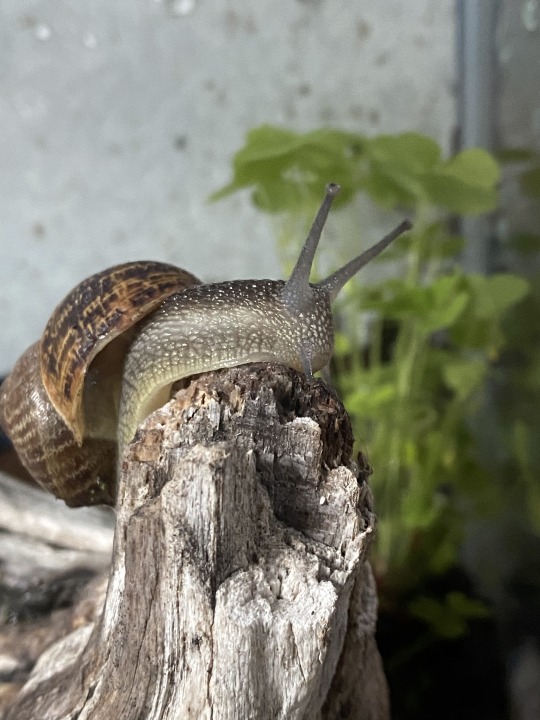
I am a common garden snail, and I am around 2 years old. Even though I'm a hermaphrodite, I have characteristics of a "male" snail, so I'm a boy ^^
Feel free to ask me anything about being a snail, how to care for snails, random snail facts, etc.
I will slime all over the keyboard as a response :3
(And also actually answer your questions as I am a very smart and educated snail.)
67 notes
·
View notes
Text
Early results coming out of the survey on intersex/perisex/endosex/dyadic in non humans
So a few weeks back I posted this rather lengthy and detailed survey asking people to come up with meanings for intersex, perisex, endosex, and dyadic in nonhumans.
📣 The survey is still open and I am still accepting responses! If you saved the link that lets you edit your responses, you can continue to refine your responses as desired. 💜
I thought I would write up the patterns I'm seeing so far because some feedback I've gotten is that it's hard to go in with a completely blank canvas. 🙂
Things there are consensus on:
A garden snail with typical sexual development - i.e. cosexual (simultaneous hermaphroditism) is non-dyadic, perisex, endosex, and not intersex. 🐌
Intersex means having any variation in sexual development relative to what is expected for the species. E.g. A female hyena with typical sex development, meaning she has a clitoris shaped like (and usable like) a penis, is not intersex.
Open questions:
Intersex: it's generally accepted that intersex includes variations in sexual development that are caused by prenatal exposure to environmental toxins. But at what point in development is it "too late" for an environmental cause of a VSD to no longer be intersex? If a baby snail is exposed to toxins and develops a VSD, is this snail intersex? (Right now the median answer is 3 out of 5 - "it could go either way".) 🤔
Dyadic: there's a general theme amongst answers that dyadic means "can be easily categorized as 'female' or 'male'" but by what/whose definition of male/female? 👀
Endosex vs perisex: these two tend to correlate pretty highly. There are four common ideas showing up for ways to differentiate the two terms usefully! 😯 But the associations of ideas to these two terms is not consistent. So one participant will define endosex as "thing A" and perisex as "thing B" and then another participant will define perisex as "thing A" and endosex as "thing B". 😵💫
Dyadism vs Non-dyadism
As of writing, there are 12 responses to the survey. I'm seeing five general approaches in defining (non-)dyadism.
The anthropomorphic approach. To ask: if a human had this organism's sex traits/development, would we call them intersex? So a female hyena with typical sex development (meaning she has a penis-shaped clitoris) is non-dyadic, because this goes against human ideas of what "female" looks like. [2 of 12 respondents]
The traditional "hermaphrodite". To ask: would this individual get any association with the h word? "Non-dyadic" hence acts as a bucket category for both intersex and biological hermaphroditism. A female hyena with typical sex development is dyadic because she is neither intersex nor a biological hermaphrodite. But "non-dyadic" would include a female clownfish with typical sex development, meaning that it first developed as a male clownfish, and then later developed into its female life stage (sequential hermaphroditism). [2 of 12 respondents]
The sex role approach. To ask: would this individual organism be understandable as "female" or "male" by members of its own species? A female clownfish with typical sex development would be dyadic. And so would a male clownfish who has an intersex condition that makes it so he can never develop into a female, because he can be easily categorized as "male". Clownfish have sex roles. But garden snails, who are simultaneous hermaphrodites, don't (to our knowledge) have sex roles because everybody has the same parts. So all of the garden snails would be non-dyadic because they don't have sex roles. [2 of 12 respondents]
The sexable approach. In biology, the verb "to sex" means to identify the sex of an organism. Would a biologist be able to easily "sex" the organism? This would take into account the standards of that species, but also that biologists understand "female" as "the mating type that makes larger gametes (eggs)". So male/female is not about sex roles, it's about reproduction. A garden snail who has an intersex variation that causes it to only have a female reproductive system would be dyadic. Because this snail is sexable as female, even if this snail comes from a species that doesn't have sex roles. [3 of 12 respondents]
Abstention. The term doesn't make sense in nonhumans. [2 respondents and one partial abstention]
Endosex vs Perisex
To a large extent, respondents (thus far) have understood endosex and perisex as being very similar. Indeed, one participant defined the two as the same.
So far, participants have created an endosex/perisex differentiation along one of the following four lines:
Etiology: is it genetic or environmental? Two participants defined perisex as having no congenital intersex variation of any type (prenatal exposure or genetic), whereas endosex has to be genetic in its basis. A third participant went the opposite direction: perisex as not-intersex and endosex means neither intersex nor a forcible sterilization.
Visibility: is any variation externally visible? Two participants defined perisex as having no externally visible intersex variation and endosex as not having any intersex variation (no matter how visible).
Impact: does any variation have a negative impact? One participant defined perisex as having no intersex variation of any type whereas endosex is not having a negatively-impactful intersex variation. Negative impact would include things like infertility and social disadvantages. So an individual with a variation that is not negatively impacting them would be perisex but not endosex. Two other participants had the same idea but the other way around: endosex is no intersex variation and perisex is not having a negatively-impacting intersex variation.
Species scope: what kind of species are we talking about? One participant defined endosex as a human-only term whereas perisex is species-independent. Once again, another participant went the opposite direction and defined endosex as the species-independent term. But perisex is having no intersex variation and also being a member of an anisogamous species (a species that produces differently-sized sex cells to mate, i.e. eggs and sperm).
One participant suggested that "ectosex" be coined as the opposite of "endosex" and I kinda like it. 👍️
If you have thoughts on which way to differentiate endosex from perisex, or how to define dyadic, the survey is still open!
You can share me your thoughts here. Replying/reblogging with thoughts also works. 💜
#intersex#intersex terminology#actually intersex#perisex#endosex#dyadic#dyadism#nondyadic#biology of sex#biology#zoology#coining#survey#surveys
35 notes
·
View notes
Text
13. goblincore
goblincore is an earthy, whimsical aesthetic that embraces the wild, untamed beauty of nature, specifically its grungy, imperfect aspect aspects. think moss-covered rocks, muddy trails, and a love for small treasures and trinkets. it shows a love for foraging, hoarding, and finding joy in nature's overlooked details. here's a breakdown on goblincore!!!!!!!!!!!!
origins and development
roots in nature: goblincore stems from a deep connection to nature, especially its wilder and less manicured sides. the aesthetic grew through online platforms like Tumblr and Instagram in the late 2010s, drawing inspiration from fantasy creatures like goblins, who are known for their love of shiny objects collecting, and dwelling in forests.
imperfection: unlike more polished aesthetics, goblincore finds beauty in decay, dirt, and chaos. it's about embracing the idea that nature is perfect even in its imperfections.
community: goblincore is also connected to sustainable, eco-friendly living and anti-consumerism, aligning with environmental activism and these slow-living movements.
key motifs
nature themes: mushrooms, moss, snails, frogs, acorns, and ferns are central motifs. natural elements like rocks, soil, and tree bark inspire color and texture choices.
color palette: earthy greens, browns, and neutrals dominate. accents of mustard yellow, rusty orange, and muted reds add a pop of warmth.
clothing and accessories: oversized sweaters, corduroy pants, and dungarees create a cozy, practical look. accessories include satchels, scarves, and nature-inspired jewelry like mushroom pendants or twig rings. practical footwear like hiking boots or muddy sneakers fits the aesthetic.
trinkets and hoards: collecting small, shiny, or natural objects like pebbles, shells, or broken jewelry, is a cornerstone of goblincore. displaying collections in jars or on shelves is common.
music
goblincore music leans towards folksy, earthy sounds that evoke feelings of wandering through a forest. nature sounds like rain, rustling leaves, or streams paired with a soft acoustic instrumental. goblincore playlists often mix fantasy-inspired tracks with nature recordings. here are some artists I recommend!!!!!!!!!!
fleet foxes
the oh hellos
cosmo sheldrake
hozier
alex g
cavetown
fish in a birdcage
kimya dawson
yaelokre
stealing sheep
movies
films that blend fantasy and nature are perfect for goblincore enthusiasts! here are some movies I suggest!!!!!!!!
The Hobbit
Pan's Labyrinth
My Neighbor Totoro
Spirited Away
Fantastic Mr Fox
The Dark Crystal
Labyrinth
The Lord of the Rings
The Dark Cauldron
The Princess and The Goblin
books and other media
books: goblincore readers love stories that focus on nature, small magical beings, and whimsical adventures. some examples are The Hobbit by J.R.R. Tolkien, The Secret Life of Trees by Peter Wohlleben, and The Wind in the Willows by Kenneth Grahame.
crafts and DIY: goblincore fans enjoy foraging and crafting with natural materials, like creating moss terrariums, homemade candles, or pressed flower art.
games: games like Stardew Valley, Animal Crossing, and The Legend of Zelda: Breath of the Wild, embody Goblincore's cozy nature focus vibe.
lifestyle
foraging: searching for mushrooms, edible plants, or trinkets in nature is a popular activity.
eco-friendly living: many goblincore enthusiasts incorporate sustainable practices, like reducing waste, gardening, or composting.
cottage decor: homes often feature cozy, rustic decor with earthy tones, vintage items, and plenty of greenery.
inspo

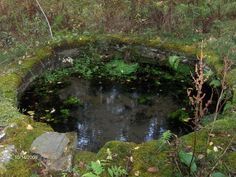
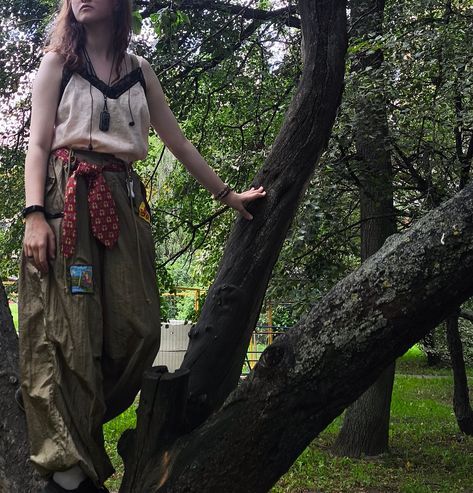

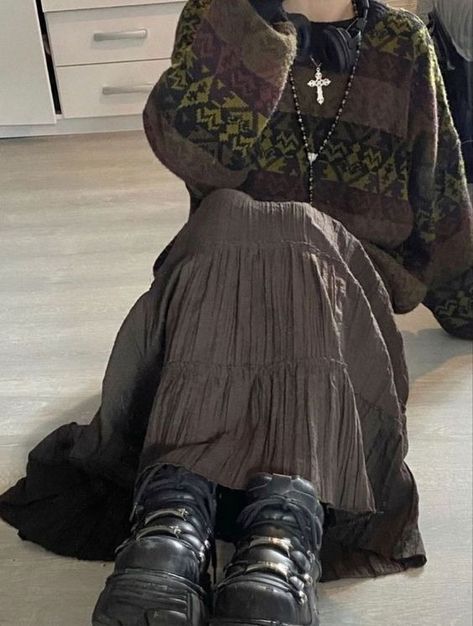
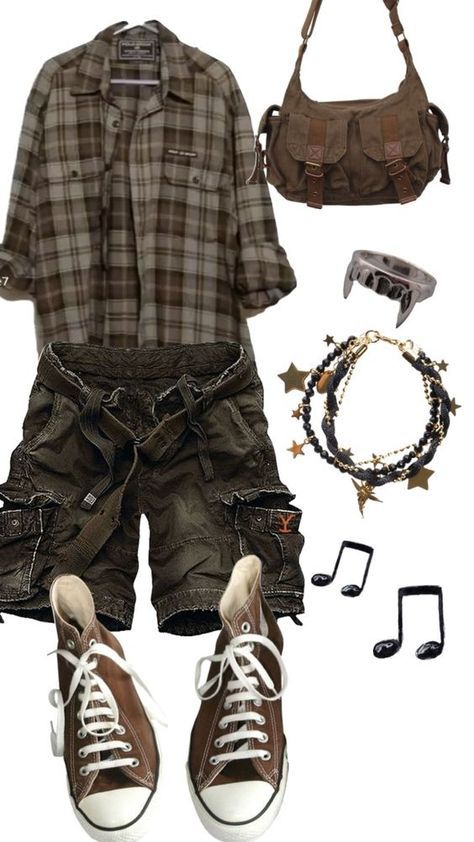

goblincore is a celebration of nature's messy, magical beauty. with its earthy tones, whimsical motifs, and practical yet cozy clothing, it encourages a life connected to the wild, untamed world around us. it's perfect for anyone who finds joy in tiny treasures, the crunch of leaves underfoot, and the magic of a mossy forest floor.
make sure to like, comment, follow, and reblog for more style breakdowns!!!!!!! use my questions box to suggest styles for me to look into.
videostar logging off...........................................................................................................................................................................................................................................................
#fashion#i love this movie#movie poster#movies#films#style#favorite movies#fashionblogger#femcel#cinema#goblincore#farmcore#cottagecore#cottage aesthetic#grandmacore#forestcore#feminism#feminine sissy#female rage#female manipulator#female hysteria#girl thoughts#gaslight gatekeep girlblog#girl interrupted#girl blogger#girlblog#girlblogging#girl interrupted syndrome#girlcore#hell is a teenage girl
11 notes
·
View notes
Note
Any updates on getting a snail?
this morning i found a snail in my garden. i fed him a banana slice (he loved it). i showed him will wood and the tapeworms (no reaction) and then i showed him my friends youtube chanel (and skibidi toilet)
my parents let me keep him, so i now. have. a. RINGO!!!!!

hes sleeping rn


so yeah i have one now!
#snails#snail#my snail#my post#snail posting#snailblr#snail mail#ringo snail#ringo the snail#answered#ask#garden snails#pet snail#pet snails#cornu aspersum#common garden snail#garden snail
24 notes
·
View notes
Text

Common garden snail (Cornu aspersum)
18 notes
·
View notes
Text
Animals I am keeping right now: ball python, Kenyan sand boa, boa imperator, orange baboon tarantula, Asian forest scorpion, desert hairy scorpion, striped bark scorpion, grove snail, European garden snail, A. Phaiodactylus (not sure if they have a common name), blue death feigning beetles, dairy cow isopods, little sea isopods, peach isopods, hissing cockroaches, Texas desert millipede, daisys blue rice fish.... I guess I will count springtails.... I think that is it...
22 notes
·
View notes
Note
one of my pet snails died :( he was only a common garden snail but i loved him... rest in peace clyde
:( <3
24 notes
·
View notes
Text

🪲🪰🦗How to Keep Your Garden Pest-Free Naturally?
✅Keeping your garden pest-free naturally requires a combination of preventive methods, companion planting, and biological controls. Here are some effective ways to manage pests without chemicals:
1. Companion Planting:
Grow pest-repelling plants like marigolds, basil, and garlic near susceptible crops to deter insects.
2. Introduce Beneficial Insects:
Encourage ladybugs, lacewings, and parasitic wasps that prey on common garden pests.
3. Neem Oil & Homemade Sprays:
Use natural insecticides like neem oil or sprays made with garlic, soap, and water to keep pests at bay.
4. Handpicking & Traps:
For larger pests like caterpillars and slugs, manual removal or using traps is effective. Beer traps work well for slugs and snails.
5. Mulching & Crop Rotation:
Organic mulch reduces pest hiding spots while rotating crops prevents pest build-up.
6. Healthy Soil & Proper Watering:
Strong plants are more resistant to pests. Enrich the soil with compost and avoid overwatering, which attracts pests like fungus gnats.
7. Physical Barriers:
Use row covers, mesh, or garden netting to block insects from laying eggs on plants.
✅These methods allow you to enjoy a lush, productive garden without harming your environment or health.
#OrganicGardening#PestFreeGarden#NaturalPestControl#SustainableGardening#EcoFriendly#gardening#plants#gardeninghour
13 notes
·
View notes
Text
Glowworms
(because i keep getting asked about them)
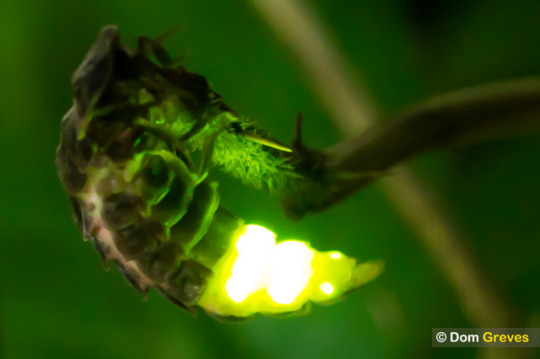
[ID: An adult female glowworm of the species Lampyris noctiluca. It has a bright green glow and clings to a plant.]
Before I even get started, let me lay down some education on the entire Lampyridae family so that we're all on the same page about the specific species that I'm going to talk about for the UK. I've done more research on this topic than the last time I brought it up, and I come bearing knowledge
Lampyridae is a family of beetles, descended from a bio-luminescent ancestor. There are more than 2000 species of Lampyridae, and they can be VERY different. This family is called "fireflies," "glowworms," and "lightningbugs" but ALL of those common names are AWFUL for referring to the full family becaaaaaauuuusee...
Not all lampyridae can fly
Not all lampyridae can glow as adults
Not all lampyridae light up passively; some use it as a lure or a warning
Not all lampyridae light up during flight
In the US, our most iconic species light up during flight, and our most common species have males and females capable of flight. So when I'm talking about "glowworms," remember that those traits are not shared by ALL species of Lampyridae, and especially not this one.
The UK has one species of glowing Lampyridae, Lampyris noctiluca, the Common Glowworm. There's one other, non-glowing species but it's extremely rare and only in the south, and an occasional visitor from mainland Europe.
GLOWWORMS
Only the female lights up, and her final stage is not capable of flight. This is called a "larviform female," because she looks like the wormy adolescent stage that all Lampyridae go through.
The female will climb up to the highest blade of grass she can find and wiggle her butt around until a male, who CAN fly and does NOT glow, finds her. Then she lays eggs and dies.
So because the adults do not eat and quickly die after reproduction, most of a glowworm's life is spent as a larva.
The larval glowworm is a SPECIALIZED predator of gastropods. They hunt snails and slugs for ONE or TWO YEARS (depending on how much food there was in the first year), hibernating over the winter, then waking up and doing it again. All movement in the species is done by the larvae; they have a REALLY hard time establishing new colonies because of this.
This is NOT a pioneer species. You need to have undisturbed grass, moor, or heath, no pesticides, not overgrazed, not brightly lit, for generations of these insects AND their prey. It's REALLY easy to decimate the glowworm population in an area via carelessness.
(let alone the horror story in the Glowworm Survey page where a tiny colony was intentionally destroyed, which is why they have a policy about keeping quiet on reports of certain colonies except to researchers ;_;)
so LOOK AT ME
HOLDING YOU BY THE SHOULDERS
You need to protect glowworm populations when you can. If you ever briefly hear posts in passing shouting about sterile lawns, light pollution, and pesticides, THIS IS WHY. If you live on the island and feel like there's a shit ton of slugs in your garden for some reason? Might be because these factors killed off their specialized predators, leaving you with an unfilled ecological niche.
Environment
Hypothetically, glowworms should be distributed all across Great Britain, except the Scottish highlands, though they have the strongest concentration in southern England.
Functionally, their population is incredibly fragmented. They need tall grass or heather, low light pollution, undisturbed (no pesticide) land, and lots of gastropods to eat. While they can work with forest verges and railways, places for them to thrive are getting rarer and rarer in the UK.
So to restate their very specific environmental needs;
Undisturbed land Glowworms and construction don't mix. Pollution, pesticides, and destruction can destroy the little patches of land glowworms have left. They need up to two years to go from eggs to adults, and a safe place for that to happen in.
A population of gastropods Baby glowworms eat slugs and snails. Because of that, they can't live where it's too dry.
Tall grasses, shrubs, or heathers, but not TOO tall A tree won't do! Glowworms do not live in trees! The females need a tall stalk to climb to the top of, so that they can signal to flying males. At the same time, they can't hunt or find each other in a savanna or a wheat field. Well-managed heathlands are excellent habitat for glowworms.
Low light pollution If it's too bright, males can't find females. Highways with heavy traffic, urban areas, and anything else that gives off constant light will affect the glowworm population.
They glow in June to May, in summer, at night. You won't find glowworms in winter, as all the larvae are hibernating at that time.
BB FAQ
When I determine if something will show up in the Better Bones AU and my Clan Culture expansions, I use iNaturalist to suss out if people are seeing it in the modeled region. Lads, there is a bald spot in my modeled regions. It's almost comical. The closest is in DERBYSHIRE, RIGHT out of reach.
So I'm still unsure about adding them. For now, they are not in BB. I GOT A REPORT FROM A FAN I will be adding them to BB.
"How do Clan cats feel about them?" They're unfathomnably holy, especially because they spend their larval stage eating snails which can be used in divination rituals. WindClan in particular considers themselves blessed for living around them.
"Can you use glowworms to light up the night?" Yes but that's really bad for their populations; leave them be! Clan cats wouldn't use something so holy in such a trivial way.
"Can you eat glowworms?" No they taste really bad. The chemical that makes them light up is REALLY bitter, and it's present in both the larvae and adults. Plus Clan cats wouldn't eat something so holy.
103 notes
·
View notes
Photo



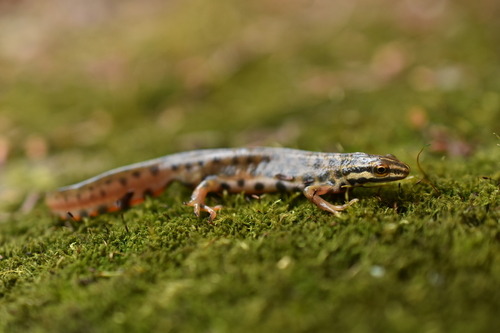
The Smooth Newt with the Smooth Moves
Also known as the European newt, northern smooth newt, or common newt (Lissotriton vulgaris), the smooth newt is one of the most common species in Europe and western Asia. It is also the only newt species found in Ireland. There are currently three recognised subspecies distributed throughout this range, and four others have been reclassified as distinct species. The common newt is able to survive in a variety of habitats, including deciduous and coniferous forests, wetlands, meadows, parks, and gardens. Their only requirements are sufficient sunlight and water with sufficient vegetation.
Like most newts, the northern smooth newt spends the majority of its time foraging for food on land. Their diet is carnivorous, consisting of insects, worms, snails, slugs, and larvae. When available, L. vulgaris may also eat the eggs of its own species. In turn, many animals prey on the European newt, including waterbirds, snakes, frogs, and larger newts. To avoid these predators the smooth newt is active mainly at night, and will secrete a toxic mucus when threatened. While active, they are largely solitary but from October to March several individuals will hibernate together under logs or leaf litter burrows.
Almost as soon as the common newt emerges from hibernation, they begin migration to their breeding sites-- usually the ponds in which they spawned. Males undergo a dramatic transformation, growing large crests and becoming brightly colored. When a female enters the water, the male swims around her and sniffs her cloaca. He then vibrates his tail to fan his pheromones towards her. Finally, he will swim away and, if the female is interested, she will follow him. He then deposits a packet of sperm, or spermatophore, that the female picks up for fertilization. Rival males may try to lead the female towards their own spermatophores, and clutches of eggs often have multiple fathers.
Females deposit anywhere from 100 to 500 eggs, each of which is carefully wrapped in aquatic vegetation. Larvae hatch after only 20 days, and quickly begin developing. Unlike frogs and toads, newt larvae have external, feathery gills, and develop their front legs first. After about three months, the larvae absorb their gills and leave the water as newtlets or efts. However, when temperatures are particularly low and aquatic prey is abundant, some adults retain their gills and stay aquatic in a phenomenon known as paedomorphism. These adults are fully capable of sexual reproduction, and when moved to areas with a larger population will often metamorphose into terrestrial adults.
Adult smooth newts are rather small, reaching only 9–11 cm (3.5–4.3 in) and 0.3��5.2 g (0.011–0.183 oz). Males are slightly larger than females. The head and back are dark brown or olive, while the underside is much lighter. Both males and females have dark spots on their bellies, and males also sport a bright orange stripe. In the spring, the colors in males become more vivid and the spots grow larger. Males also develop a large yellow crest that runs from the head to the table, and is dotted with dark bands.
Conservation status: The IUCN has designated the European newt as Least Concern, as it is common over most of its range. Threats include habitat destruction and the introduction of invasive fish species.
If you like what I do, consider leaving a tip or buying me a ko-fi!
Photos
Philip Precey
Derek Middleton
Christoph Moning via iNaturalist
Kristýna Coufalová via iNaturalist
#common newt#smooth newt#Urodela#Salamandridae#newts#salamanders#amphibians#deciduous forests#deciduous forest amphibians#evergreen forests#evergreen forest amphibians#grassland birds#grassland amphibians#wetlands#wetland amphibians#urban fauna#urban amphibians#europe#asia#west asia#animal facts#biology#zoology
149 notes
·
View notes